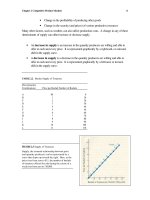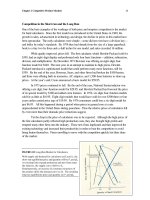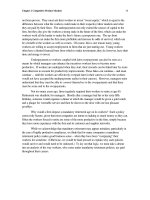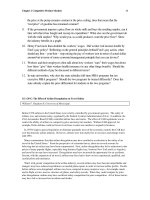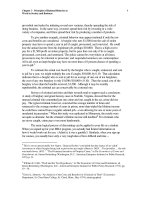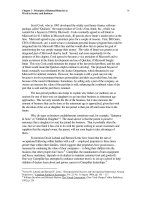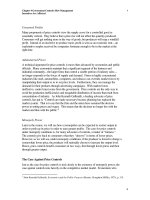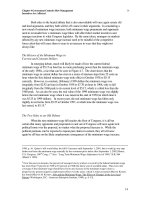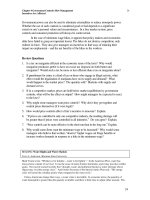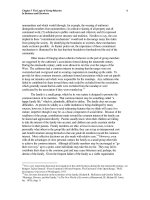Tài liệu Microeconomics for MBAs 20 doc
Bạn đang xem bản rút gọn của tài liệu. Xem và tải ngay bản đầy đủ của tài liệu tại đây (62.26 KB, 10 trang )
Chapter 6. Reasons for Firm Incentives
9
efforts. Such a finding means that if each worker added to the group must be paid the same as
all others, the cost of additional production obviously rises with the size of the working group.
The finding also implies that to get a constant increase in effort with the additional workers, all
workers must be given greater incentive to hold to their previous level of effort.
12
Optimum Size Firms
How large should a firm be? Contrary to what might be thought, the answer depends on more
than “economies of scale” technically specified. Technology determines what might be
possible, but it doesn’t determine what will happen. And what happens depends on policies
that minimize shirking and maximize the use of the technology by workers. This means that
scale economies depend as much or more on what happens within any given firm as they do on
what is technologically possible. The size of the firm obviously depends on the extent to which
owners must incur greater monitoring costs as they lose control with increases in the size of the
firm and additional layers of hierarchy (a point well developed by Oliver Williamson in his
classic article written more than thirty years ago
13
). However, the size of the firm also depends
on the cost of using the market.
Management information Professors Vijay Gurbaxani and Seungjin Whang have
devised a graphical means of illustrating the “optimal firm size” as the consequence of two
forces: “internal coordinating costs” and “external coordinating costs.”
14
As a firm expands, its
internal coordinating costs are likely to increase. This is because the firm’s hierarchical pyramid
will likely become larger with more and more decisions made at the top by managers who are
further and further removed from the local information available to workers at the bottom of the
pyramid. There is a need to process information up and down the pyramid. When the
information goes up, there are unavoidable problems and costs: costs of communication, costs
of miscommunication, and opportunity costs associated with delays in communication, all of
which can lead to suboptimal decisions. These “decision information costs” become
progressively greater as the decision rights are moved up the pyramid.
Attempts to rectify the decision costs by delegating decision making to the lower ranks
may help, but this can – and will -- also introduce another form of costs -- which, you will
recall, we previously have called agency costs. These include the cost of monitoring (managers
12
Workers can also reason that if the residual from their added effort goes to the firm owners, they can
possibly garner some of the residual by collusively (by explicit or tacit means) restricting their effort and
hiking their rate of pay, which means that the incentive system must seek to undermine such collusive
agreement. For a discussion of these points see, Felix R. FitzRoy and Kornelius Kraft, “Cooperation,
Productivity, and Profit Sharing,” Quarterly Journal of Economics (February 1987), pp. 23-35.
13
Oliver E. Williamson, “Hierarchical Control and Optimum Size Firms,” Journal of Political Economy, vol. 75
(no. 2, 1967), pp. 123-138.
14
Vijay Gurbaxani and Seungjin Whang, “The Impact of Information Systems on Organizations and
Markets,” Communication of the ACM, January 1991, pp. 59-73.
Chapter 6. Reasons for Firm Incentives
10
actually watching employees as they work or checking their production) and bonding (workers
providing assurance that the tasks or services will be done as the agreement requires), and the
loss of the residual gains (or profits) through worker shirking, which we covered earlier.
The basic problem managers face is one of balancing the decision information costs with
agency costs and finding that location for decision rights that minimizes the two forms of costs.
From this perspective, where the decision rights are located will depend heavily on the amount
of information flow per unit of time. When upward flow of information is high, the decision
rights will tend to be located toward the floor of the firm, mainly because the costs of suboptimal
decisions by having the decision making done high up the hierarchy will be high. The firm, in
other words, can afford to tolerate agency costs because the costs of avoiding the them, via
centralized decisions, can be higher.
Nevertheless, as the firm expands, we should expect that the internal coordinating costs
along with the cost of operations will increase. The upward sloping line in Figure 6.1 depicts
this relationship.
But internal costs are not all that matter to a firm contemplating an expansion. It must
also consider the cost of the market, or what Gurbaxani and Whang call “external coordination
costs.” If the firm remains “small” and buys many of its parts, supplies, and services (such as
accounting, legal, and advertising services) from outside venders, then it must cover a number of
what we have called “transaction costs.” These include the costs of transportation, inventory
holding, communication, contract writing, and contract enforcing. However, as the firm expands
in size, then these transaction costs should be expected to diminish. After all, a larger firm seeks
to supplant market transactions. The downward sloping line in Figure 6.1A depicts this inverse
relationship between firm size and transaction costs.
Again, how large should a firm be? If a firm vertically integrates, it will engage in fewer
market transactions, lowering its transaction costs. It can also benefit from economies of scale,
the technical kind mentioned earlier. However, in the process of expanding, it will confront
growing internal coordination costs, or all of the problems of trying to move information up the
decision making chain, getting the “right” decisions, and then preventing people from exploiting
their decision making authority to their own advantage.
The firm should stop expanding in scale and scope when the total of the two types of
costs -- external and internal coordinating costs -- are minimized. This minimum can be shown
graphically by summing the two curves in Figure 6.1A to obtain the U-shaped curve in Figure
6.1B. The optimal (or most efficient/cost-effective) firm size is at the bottom of the U.
This way of thinking about firm size would have only limited interest if it did not lend
itself to a couple of additional observations, which permit thinking about the location, shape, and
changes in the curve. First, the exact location of the bottom will, of course, vary for different
firms in different industries. Different firms have different capacities to coordinate activities
Chapter 6. Reasons for Firm Incentives
11
through markets and hierarchies. Second, firm size will also vary according to the changing
abilities of firms to coordinate activities internally and externally.
___________________________________
Figure 6.1A and 6.1B External and Internal
Coordinating Costs
As the firm expands, the internal coordinating costs
increase as the external coordinating costs fall. The
optimum firm size is determined by summing these
two cost structures, which is done in the bottom
half of the figure.
_______________________________________
__
A firm that is efficient at processing information will be larger, everything else equal, than
one that isn’t so able. If a firm is able to improve the efficiency of its upward information flow
and reduce the number of wrong decisions, then the upward sloping curve in Figure 6.1A will
move down and to the right, causing the sum of the two curves in the bottom panel of the figure
to move to the right, for a greater optimal size firm. If the costs of using markets go down, the
firm size can be expected to decline, not because the firm has become less efficient internally (it
may have become more efficient), but because markets are now relatively more cost effective.
Again, from this perspective, the size of the firm changes for reasons other than those related to
the technology of actual production. It depends on the ability of managers to squeeze out the
scale economies that are possible from their workers.
Of course, knowing that the owners will always worry that their manager-agents will
exploit their positions for their own benefit at the expense of the owners, managers will want to
“bond” themselves against exploitation of their positions. (And we don’t use the term “bond” in
the modern pop-psychology sense of developing warm and fuzzy relationships; rather, we use it
in the same sense that is common when accused criminals post a bond, or give some assurance
that they will appear in court if released from jail.) That is to say, managers have an interest in
letting the owners know that they, the managers, will suffer some loss when exploitation occurs.
Chapter 6. Reasons for Firm Incentives
12
Devices such as audits of the company are clearly in the interest of stockholders. But they are
also in the interest of managers by reducing the scope for managerial misdeeds, thus increasing
the market value of the company – and the value of its managers. By buying their companies’
stock, manager-agents can also bond themselves, assuring stockholders that they will incur at
least some losses from agency costs. To the extent manager-agents can bond themselves
convincingly, the firm can grow from expanded sources of external investment funds. By
bonding themselves, manager-agents can demand higher compensation. Firms can be expected
to expand and contract with reductions and increases in the costs of developing effective
managerial bonds.
15
Changes in Organizational Costs
Finally, we can observe that the size of the firm can be expected to change with changes in the
relative costs of organizing a given set of activities by way of markets and hierarchies. For
example, suppose that the costs of engaging in market transactions are lowered, meaning
markets become relatively more economical vis a vis firms. Entrepreneurs should be expected
to organize more of their activities through markets, fewer through firms. Then, those firms that
more fully exploit markets, and rely less on internal directions, should be able to increase the
payments provided workers and other resources that they buy through markets, collectively
leaving fewer resources to expand their market share relative to those firms that make less use
of markets. Accordingly, firms should be expected to downsize, to use a popular expression.
An old, well-worn, and widely appreciated explanation for downsizing is that modern
technology has enabled firms to produce more with less. Personal computers, with their ever-
escalating power, have enabled firms to lay off workers (or hire fewer workers). Banks no
longer need as many tellers, given the advent of the ATMs.
One not-so-widely-appreciated explanation is that markets have become cheaper,
which means that firms have less incentive to use hierarchical structures and more incentive to
use markets. And one good reason firms have found markets relatively more attractive is the
rapidly developing computer and communication technology, which has reduced the costs of
entrepreneurs operating in markets. The new technology has lowered the costs of locating
suitable trading partners and suppliers, as well as negotiating, consummating, and monitoring
market-based deals (and the contracts that go with them). In terms of Figure 6.1, the
downward sloping transaction costs curve has dropped down and to the left, causing the
bottom of the U to move leftward.
“Outsourcing” became a management buzzword in the 1980s because the growing
efficiency of markets, through technology, made it economical. Outsourcing continued apace in
the 1990s. Of 26 major companies surveyed, 86 percent said they outsourced some activity in
15
See Michael C. Jensen and William H. Meckling, “Theory of the Firm: Managerial Behavior, Agency Costs
and Ownership Structure,” Journal of Financial Economics, vol. 3 (October 1976), pp. 325-328.
Chapter 6. Reasons for Firm Incentives
13
1995, up from 58 percent who gave the same response in 1992, with the budding outsourcing
industry generating $100 billion in annual revenues by 1996.
16
For all practical purposes,
airlines now outsource the acquisition of their reservations through independent contractors
called travel agents, given that more than 70 percent of all airline reservations are now taken by
such agents, working through computerized markets, not through the hierarchical structures
within the airlines.
Modern technology has also improved the monitoring of employees, reducing agency
costs, which has been a force for the expansion of firms. This is because firms have been able
to use the technology to garner more of the gains from economies of scale and scope. The
optical scanners at grocery store checkout counters are valuable because they can speed up the
flow of customers through the checkout counters, but they can also be used for other purposes,
such as inventory control and restocking. Each sale is immediately transmitted to warehouse
computers that determine the daily shipments to stores. The scanners can also be used to
monitor the work of the clerks, a factor that can diminish agency costs and increase the size of
the firm. (We are told that even “Employee of the Month Awards” are made based on reports
from scanners.) Books on Tape, a firm that rents audio versions of books, tracks its production
of tapes by way of scanners not so much to reward and punish workers, but to be able to
identify problem areas. In terms of Figure 6.1, the upward sloping curve moves down and to
the right, while the U-shaped curve in the lower panel moves to the right.
Frito-Lay has issued its sales people hand scanners in part to increase the reliability of
the flow of information back to company distribution centers, but also to track the work of the
sales people. The company can obtain reports on when each employee starts and stops work,
the time spent on trips between stores, and the number of returns. The sales people can be
asked to account for more of their time and activities while they are on the job.
Obviously, we have not covered the full spectrum of explanations for the rich variety of
sizes of firms that exists in the “real world” of business. We have also left the net impact of
technology somewhat up in the air, given that it is pressing some firms to expand and others to
downsize. The reason is simple: technology is having a multitude of impacts that can be
exploited in different ways by firms in different situations.
Prisoners’ Dilemma Problems, Again
The discussion to this point reduces to a relatively simple message: Firms exist to bring about
cost savings, and they generate the cost savings through cooperation. However, cooperation is
not always and everywhere “natural”; people have an incentive to “cheat,” or not do what they
are supposed to do or have agreed to do. This may be the case because of powerful incentives
to toward noncooperation built-in to many business environments.
16
As reported by John A. Byrne, “Has Outsourcing Gone Too Far?” Business Week, April 1, 1996, p. 27.
